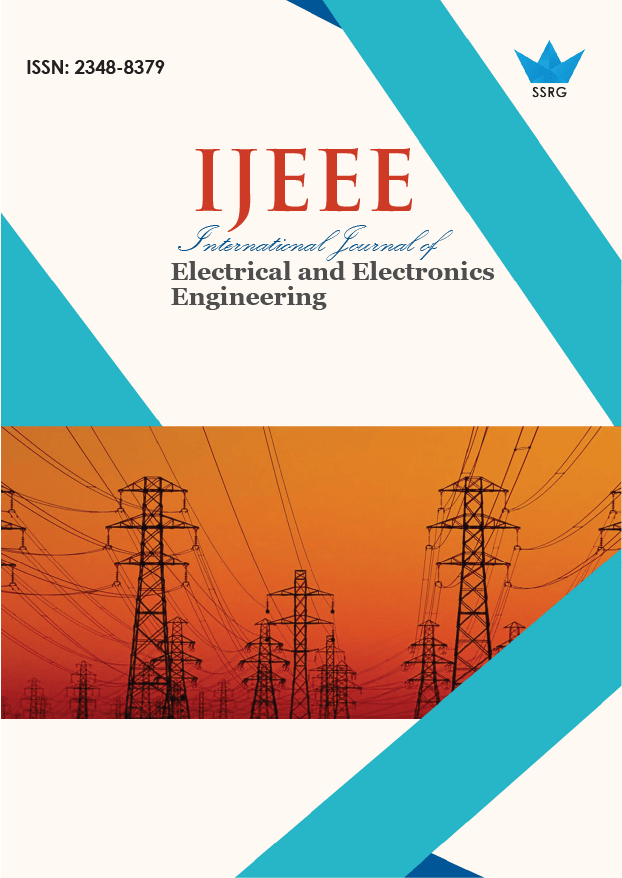Optimal Reactive Power Control Strategy of a Hybrid Power System Using Sine Cosine Algorithm and STATCOM-POSICAST Controller

| International Journal of Electrical and Electronics Engineering |
| © 2025 by SSRG - IJEEE Journal |
| Volume 12 Issue 5 |
| Year of Publication : 2025 |
| Authors : Gomar Bam, Pabitra Kumar Guchhait, Abhik Banerjee |
How to Cite?
Gomar Bam, Pabitra Kumar Guchhait, Abhik Banerjee, "Optimal Reactive Power Control Strategy of a Hybrid Power System Using Sine Cosine Algorithm and STATCOM-POSICAST Controller," SSRG International Journal of Electrical and Electronics Engineering, vol. 12, no. 5, pp. 253-260, 2025. Crossref, https://doi.org/10.14445/23488379/IJEEE-V12I5P121
Abstract:
Reactive power mismatches in power systems can cause serious problems, especially making the system unstable. This instability can damage the power grid very quickly, in just a few milliseconds. So, it’s very important to manage reactive power properly during disturbances to keep the system operating safely. Reactive power in power systems is managed by the proper use of FACTS devices. They precisely modify reactive power to correspond with the demands of the system’s load. This study has applied an alternative optimal reactive power management technique to enhance system performance and stability in the presence of minor disturbances. The main goal of this work is to improve reactive power regulation in a standalone wind diesel hybrid power system. It takes advantage of a POSICAST controller and a FACTS device known as a static synchronous compensator (STATCOM). The desired results obtained through the proposed control strategy are compared with the model without using the controller. To modify the controller parameters, similar comparisons are made between the outcomes and the used soft computing algorithms, such as the Sine- Cosine Algorithm (SCA) and Gravitational Search Algorithm (GSA).
Keywords:
Hybrid power system, Reactive power compensation, STATCOM controller, Soft computing.
References:
[1] Ibrahim Dincer, “Renewable Energy and Sustainable Development: A Crucial Review,” Renewable and Sustainable Energy Reviews, vol. 4, no. 2, pp. 157-175, 2000.
[CrossRef] [Google Scholar] [Publisher Link]
[2] Zifan Zhang et al., “Highly Applicable Small Hydropower Microgrid Operation Strategy and Control Technology,” Energy Reports, vol. 6, pp. 3179-3191, 2020.
[CrossRef] [Google Scholar] [Publisher Link]
[3] Ramesh C. Bansal, and T.S. Bhatti, Small Signal Analysis of Isolated Hybrid Power Systems: Reactive Power and Frequency Control Analysis, The University of the South Pacific, 2008.
[Google Scholar] [Publisher Link]
[4] Yu Zou, Malik E. Elbuluk, and Yilmaz Sozer, “Simulation Comparisons and Implementation of Induction Generator Wind Power Systems,” IEEE Transactions on Industry Applications, vol. 49, no. 3, pp. 1119-1128, 2013.
[CrossRef] [Google Scholar] [Publisher Link]
[5] P. Sharma et al., “Reactive Power Compensation of Isolated Wind-Diesel Hybrid Power Systems with STATCOM and SVC,” International Journal on Electrical Engineering and Informatics, vol. 2, no. 3, pp. 192-203, 2010.
[CrossRef] [Google Scholar] [Publisher Link]
[6] Nitin Kumar Saxena, and Ashwani Kumar, “Reactive Power Control in Decentralized Hybrid Power System with STATCOM using GA, ANN and ANFIS Methods,” International Journal of Electrical Power and Energy Systems, vol. 83, pp. 175-187, 2016.
[CrossRef] [Google Scholar] [Publisher Link]
[7] Pawan Sharma, T.S. Bhatti, and K.S.S. Ramakrishna, “Study of an Isolated Wind–Diesel Hybrid Power System with STATCOM by Incorporating a New Mathematical Model of PMIG,” European Transactions on Electrical Power, vol. 22, no. 3, pp. 351-363, 2012.
[CrossRef] [Google Scholar] [Publisher Link]
[8] Youssef Ait El Kadi, Fatima Zahra Baghli, and Yassine Lakhal, “PV-STATCOM in Photovoltaic Systems under Variable Solar Radiation and Variable Unbalanced Nonlinear Loads,” International Journal of Electrical and Electronic Engineering and Telecommunications, vol. 10, no. 1, pp. 36-48, 2021.
[CrossRef] [Google Scholar] [Publisher Link]
[9] Yaa Xu et al., “Flatness-Based Adaptive Control (FBAC) for STATCOM,” Electric Power Systems Research, vol. 122, pp. 76-85, 2015.
[CrossRef] [Google Scholar] [Publisher Link]
[10] Esmat Rashedi, Hossein Nezamabadi-Pour, and Saeid Saryazdi, “GSA: A Gravitational Search Algorithm,” Information Sciences, vol. 179, no. 13, pp. 2232-2248, 2009.
[CrossRef] [Google Scholar] [Publisher Link]
[11] S. Panda, and R.N. Patel, “Optimal Location of Shunt FACTS Controllers for Transient Stability Improvement Employing Genetic Algorithm,” Electric Power Components and Systems, vol. 35, no. 2, pp. 189-203, 2007.
[CrossRef] [Google Scholar] [Publisher Link]
[12] Kang Seok Lee, and Zong Woo Geem, “A New Structural Optimization Method Based on the Harmony Search Algorithm,” Computers and Structures, vol. 82, no. 9-10, pp. 781-798, 2004.
[CrossRef] [Google Scholar] [Publisher Link]
[13] Seyedali Mirjalili, “SCA: A Sine Cosine Algorithm for Solving Optimization Problems,” Knowledge-Based Systems, vol. 96, pp. 120 133, 2016.
[CrossRef] [Google Scholar] [Publisher Link]
[14] Narain G. Hingorani, and Laszlo Gyugyi, Understanding FACTS: Concepts and Technology of Flexible AC Transmission Systems, Wiley IEEE Press, 2000.
[Google Scholar] [Publisher Link]
[15] Otto J.M. Smith, “Posicast Control of Damped Oscillatory Systems,” Proceedings of the IRE, vol. 45, no. 9, pp. 1249-1255, 1957.
[CrossRef] [Google Scholar] [Publisher Link]
[16] M. R. Aghamohammadi, A. Ghorbani, and S. Pourmohammad, “Enhancing Transient and Small Signal Stability in Power Systems using a Posicast Excitation Controller,” IEEE 43rd International Universities Power Engineering Conference, Padua, Italy, pp. 1-5, 2008.
[CrossRef] [Google Scholar] [Publisher Link]

 10.14445/23488379/IJEEE-V12I5P121
10.14445/23488379/IJEEE-V12I5P121